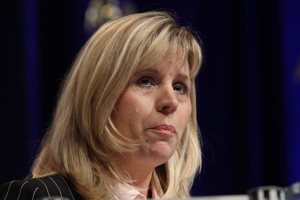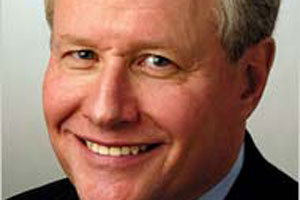
UPPA/zumapress.com
Elizabeth Cheney, daughter of Dick, draws plenty of attention these days as a feisty conservative advocate and pundit. A board member of the hawkish Keep America Safe, she often blasts President Barack Obama and his national security policies—and vigorously defends the record of the Bush-Cheney administration. (Last month, she was on television claiming it was absurd to blame her father for the regulatory failures that led to the BP oil spill in the Gulf of Mexico.) But a few years ago, Cheney was more than a mere talking head. She was a senior State Department official, and documents recently obtained by a Washington-based watchdog group show how Cheney was intimately involved in the creation of a pro-democracy foundation that has turned out to be something of a dud.
In February 2005, Cheney was appointed principal deputy assistant secretary of state for Near Eastern affairs and coordinator for Broader Middle East and North Africa (BMENA) Initiatives. (Earlier in the Bush-Cheney administration, she had held a similar position.) With the administration bogged down in Iraq and pushing a so-called “freedom agenda,” Cheney in May attended a meeting in Bahrain of representatives of G8, Middle Eastern, and North African governments, as well as civil-society groups and international organizations, who were planning a major gathering in the fall. She informed the assembled that the United States wanted that coming conference—known as the Forum for the Future—to launch a Foundation for the Future. The mission of this outfit would be to support civil society and democratic reforms throughout the Middle East.
According to a State Department cable obtained under the Freedom of Information Act by the Government Accountability Project, a public interest organization that supports whistleblowers, Cheney told the attendees at this planning meeting,
Our thought is to create an entity outside of official government donor channels which is multilateral, has a clear mandate, and whose members of its board of directors come from BMENA and donor countries.
She noted that the initial funding should be $60 million, of which the United States would pony up $35 million.
In the following months, Cheney and other State Department officials pressed other governments to make contribution pledges for the new foundation. It was not always an easy task. When US officials met with British counterparts in September 2005 to discuss the foundation, the British representatives, according to a draft cable, questioned if the Foundation for the Future could truly be a multilateral project attuned to regional priorities and sensitivities. The British officials, the cable said, wondered “whether the Foundation has enough regional backing to ensure that it has the appropriate indigenous imprint, given that it has more Western than Arab backers at present.” They predicted it would be a tough sell to Arab governments.
Cheney and the State Department plowed ahead. At a November 9, 2005, press briefing held by Cheney and Assistant Secretary of State Daniel Fried, she stressed that the foundation was “not just an effort by the United States” and that civil-society outfits in the Middle East had asked for an “entity that’s not connected to any one government, but that can provide support for their efforts to help to open up their societies.” When a Turkish reporter noted that there was “skepticism building in the Middle East about the US advocacy for democracy and human rights” due to recent news stories about the CIA’s use of black sites, Cheney replied, “Judge us by our actions…Judge us by the extent to which we are supporting NGOs with our money.” She reported that the foundation to date had attracted $9 million in funding commitments from foreign governments—much less than the $25 million she had called for months earlier. She said she expected more contributions.
A week later, at the Forum for the Future in Bahrain, US officials met with senior representatives of other governments to discuss the launch of the foundation. According to a US cable, several foreign representatives raised concerns. A Kuwaiti official, noting that governments were being called on to finance the foundation, asked how to ensure that civil-society organizations funded by the foundation wouldn’t undermine these governments. Egyptian officials pointed out that many governments regulate the funding of NGOs. Scott Carpenter, Cheney’s subordinate at the State Department, vowed that the foundation, according to a cable, “would be a completely independent organization with an independent board.” He noted that the Bush-Cheney administration was “committed” to working with governments in the region to “develop a mechanism to support the growth of civil society in the region.” The next day, Secretary of State Condoleezza Rice announced the foundation’s formation, dubbing it a “great multilateral effort—called for by the people of the Broader Middle East.”
In late November 2005, a State Department cable approved by Liz Cheney that was sent to various embassies reported that things were moving right along. The State Department was looking for someone to chair the foundation’s board, and, the cable claimed, funding commitments were pouring in:
To date, the following governments have committed funds to the Foundation: United States ($35 million), European Commission ($1.3 million), Spain ($1 million), United Kingdom ($1 million), Switzerland ($1 million), Denmark ($2 million), (Netherlands ($1 million), Greece ($1.5 million), Turkey ($500,000), Italy (TBD), Hungary (in kind), Jordan ($1 million), Qatar ($10 million), and Bahrain ($1 million).
This added up to more than $56 million. “The Foundation will be a critical tool to supporting greater freedom and democracy in the Broader Middle East,” the cable said. It noted that the foundation would be operational and soliciting grant proposals by April 2006.
Yet much of that outside support wouldn’t materialize. And the documents GAP obtained show that the foundation was a US government production, not truly a multilateral effort. For instance, the State Department contracted with the Eurasia Foundation, a nonprofit supported by the US Agency for International Development and others, to help set up the foundation. As GAP notes in a new report (PDF):
Thus the organization that was charged with making the Foundation for the Future operational reported directly to the US State Department, not to a multilateral group made up of either European and Middle Eastern governments or civil society organizations.
In March 2006, the Yemeni foreign minister complained in a letter to Rice that “a number of decisions are being taken without full participation and open debate to reach a decision. Many of the decisions concerning the Foundation for the Future are taken without the participation of the members of the forum.”
In the summer of 2006, Cheney went on maternity leave (and the following year she would resign from the State Department to join ex-GOP Sen. Fred Thompson’s presidential campaign). The State Department pushed ahead with the foundation. But come May 2007, it had yet to issue a single grant. Its first president, Bakhtiar Amin, an Iraqi who had served in the first interim government established after the US invasion, had left the foundation after a short stint. “He was not up to the task,” says a source familiar with the foundation’s operations. The group at that point also had no chief financial officer or chief operations officer. The foundation’s second president was Anwar Ibrahim, a former deputy prime minister of Malaysia and a longtime friend of Paul Wolfowitz, then the president of the World Bank. In fact, the only attention the foundation won came in the spring of 2007, when GAP released records indicating that Wolfowitz had directed that his girlfriend, Shaha Riza, a World Bank employee, be seconded to the State Department and then the Foundation for the Future and that she be awarded a large pay raise. At the foundation, Riza had overseen the selection of board members and had recruited Ibrahim as an adviser. In a way, the foundation was a neoconservative platform. Birthed in part by Vice President Cheney’s daughter, its structure and leadership were shaped by Wolfowitz’s romantic partner.
Meanwhile, the pledges from outside governments that Cheney had touted were never met. Nevertheless, the State Department kept citing these numbers—and ended up misleading Congress.
Congress initially agreed to provide up to $35 million for the Foundation for the Future, as long as there were matching grants from other governments. On June 15, 2007, as the State Department was seeking to obtain $21.3 million of this funding, the department forwarded Congress a description of the funding commitments made by other nations. This list essentially mirrored the amounts that had been included in the November 2005 cable Cheney had okayed—totaling $22 million. (In this document, the department said that Bahrain had pledged $2 million for the foundation.)
But much of this money had gone uncollected. Qatar and Bahrain had contributed none of the $12 million they had collectively promised. (They would give nothing in 2008 and 2009). The GAP report notes, “Though the US government repeatedly represented Qatar as having pledged $10 million to the Foundation for the Future beginning in 2005, there is no document from the government of Qatar that confirms that pledge. Nor is there a record of the State Department soliciting such a pledge from Qatar.”
Moreover, there was an indication that Qatar had no intention of making good on this promise, real or not. According to a June 7, 2007, cable, Qatar had donated $10 million to help establish the Arab Foundation for Democracy, which the cable described as a possible “Qatari substitute” for the Foundation for the Future. This suggests that the State Department had reason to believe the foundation would not be receiving $10 million from Qatar. Nevertheless, the department was telling Congress that this $10 million contribution was pending. As GAP puts it, “Evidence shows that State Department officials knowingly misled Congress about the financial commitments to the Foundation from sources other than the US government, in order to obtain authorization for unjustified ‘matching’ US contributions.” GAP adds, “Because the matching-funds requirement was an indicator of the multilateral character of the [foundation], and the functions of the [foundation] were predicated upon its multilateral standing, the failure of governments other than the US to underwrite it compromised the Foundation’s ability to fulfill its mission.” (In August 2007, the State Department succeeded in getting rid of the matching fund provision.)
As of March 2010, the foundation, working out of an office in Amman, Jordan, with a staff of two dozen, had made about 75 grants to civil-society groups in 15 countries. It has funded what appears to be laudable projects throughout the Middle East to bolster women rights, press freedom, an independent judiciary, and the rule of law. Its most recent annual report lists nine broad goals through 2012, with few specifics about its future plans. Yet the Foundation for the Future has not become the completely multilateral operation that Cheney insisted it would be. According to the foundation’s annual reports, it has received a total of $27.8 million in funding, of which only $6.4 million came from non-US governments. Its website proclaims it is “an independent, indigenous organization,” but it is also a US government creation—funded mostly by the United States and assembled mainly by Washington.
Asked to explain what happened to all those non-US funding commitments and whether she is disappointed that the foundation has not been a fully multilateral project, Cheney declined to comment. The foundation did not reply to a request for information regarding its funding and grants.
These days, the financial picture for the foundation seems uncertain. In 2009, it took in no income and spent $6.5 million—with a quarter of that covering administrative expenses. If the foundation keeps spending at this pace, it will be out of cash in four years.










